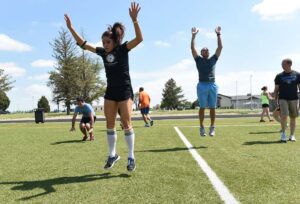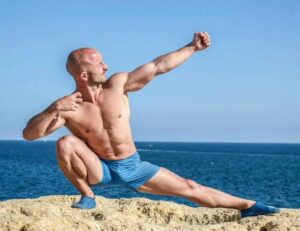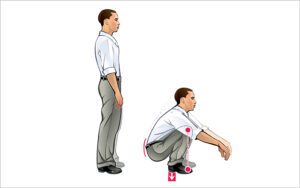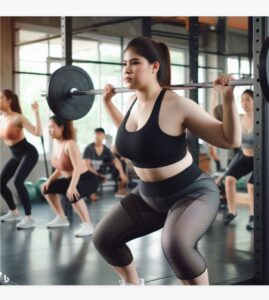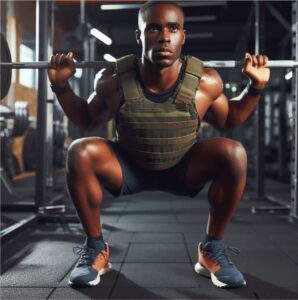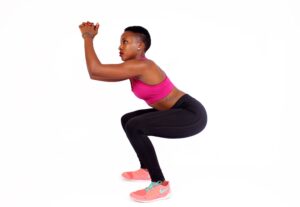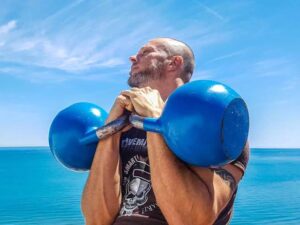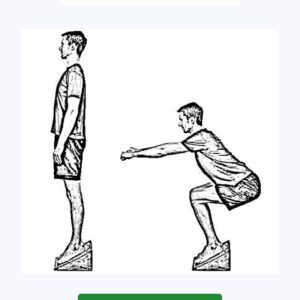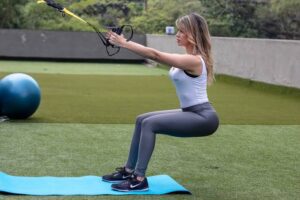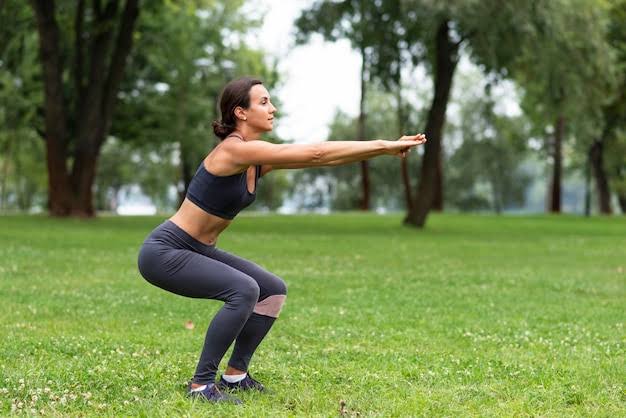
Frog squats are a challenging variation of traditional squats that target the lower body muscles in a unique way.
This exercise involves assuming a deep squat position with a wide stance and toes pointed outward, resembling a frog’s posture.
While frog squats may be more demanding than regular squats, they offer numerous benefits for strength, mobility, and overall fitness.
In this article, we will explore 12 proven benefits of incorporating frog squats into your workout routine.
Benefits of Frog Squats
Here are the 10 benefits of doing frog squats regularly and with proper form:
1. Targeted Leg Muscles:
Frog squats primarily target the muscles in your lower body, including the quadriceps, hamstrings, glutes, and calves. By taking a wider stance and turning your toes out, frog squats engage these muscle groups more intensely, allowing for greater muscle activation and development.
2. Glute Activation:
The wider stance and external rotation of the hips in frog squats specifically target the glute muscles. This exercise can help strengthen and build the gluteus maximus, medius, and minimus, leading to improved lower body strength, stability, and aesthetics.
3. Increased Range of Motion:
Frog squats require a greater range of motion compared to traditional squats. The wider stance and deep squat position help improve hip and ankle flexibility, allowing for a fuller squat depth. Over time, this can enhance overall mobility and functional movement patterns.
4. Core Engagement:
Performing frog squats requires significant core engagement to maintain balance and stability. The core muscles, including the abdominals, obliques, and lower back, work synergistically to support the movement, leading to improved core strength and stability.
5. Improved Balance and Stability:
The wider stance in frog squats challenges your balance and stability, particularly in the frontal plane. By working to maintain proper form throughout the exercise, you engage the muscles responsible for balance, leading to improved stability and coordination.
6. Enhanced Hip Mobility:
Frog squats emphasize external rotation of the hips, which helps improve hip mobility. This can be beneficial for individuals who have tight hip muscles or struggle with hip mobility in activities such as squats, lunges, or sports that require lower body agility.
7. Strengthened Knee Joints:
When performed with proper form, frog squats can help strengthen the muscles around the knee joint. This increased muscular support can potentially reduce the risk of knee injuries and improve overall knee joint stability.
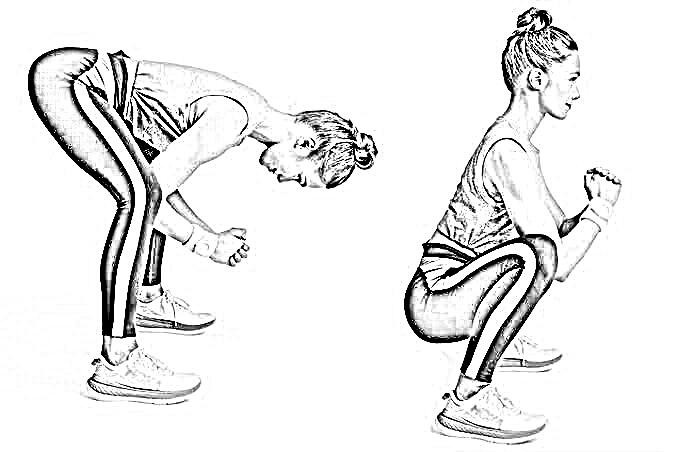
8. Glute Medius Activation:
Frog squats target the gluteus medius, a smaller muscle located on the side of the hip. Strengthening the glute medius can help improve hip stability, reduce the risk of hip and knee injuries, and enhance overall lower body function.
9. Improved Posture:
Performing frog squats with proper form encourages a more upright posture. This can help strengthen the muscles responsible for maintaining good posture, such as the erector spinae and upper back muscles, leading to improved overall posture and spinal alignment.
10. Functional Movement Benefits:
Frog squats mimic movements that are often required in daily activities, such as bending down, lifting objects, or getting up from a low position. By incorporating frog squats into your workout routine, you can improve your ability to perform these functional movements with ease and reduce the risk of injury.
11. Calorie Burning and Fat Loss:
Frog squats, like any other squat variation, are a compound exercise that engages multiple muscle groups simultaneously. This leads to an increased caloric expenditure during and after the workout, making frog squats an effective addition to a fat loss or weight management program.
12. Variation and Muscle Confusion:
Adding frog squats to your workout routine provides variation and challenges your muscles in a different way. By introducing new movements and stimulating different muscle fibers, you can prevent plateaus and promote continued muscle growth and development.
It’s important to note that frog squats may be more demanding on the knees and require proper form and mobility. Beginners or individuals with knee or hip issues should start with caution and focus on gradually increasing depth and intensity.
Consulting with a fitness professional can provide guidance on proper technique and modifications if needed.
Frog squats offer a multitude of benefits that can enhance your lower body strength, mobility, and overall fitness. From targeted muscle engagement and improved range of motion to enhanced balance, stability, and functional movement patterns, frog squats are a valuable addition to any workout routine.
Incorporate this unique squat variation to reap the proven benefits and take your fitness journey to the next level.
Remember to perform this exercise with proper form, progressively increase intensity, and listen to your body to avoid injury and maximize the benefits.
How to do Frog Squats With Proper Form to Reap it’s maximum Benefits
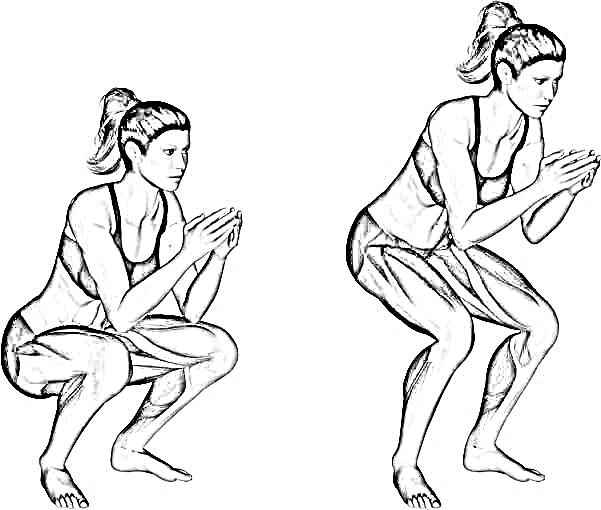
Frog squats, when performed with proper form, can provide maximum benefits for your lower body strength, mobility, and overall fitness.
In this section, we will guide you through the step-by-step process of executing frog squats correctly.
By following these instructions, you can optimize your form, target the right muscles, and reap the full Benefits of this exercise.
Step 1: Set Up Your Position
- Begin by standing with your feet wider than shoulder-width apart, toes turned out at an angle of about 45 degrees.
- Keep your chest lifted, shoulders back, and engage your core muscles to maintain stability throughout the exercise.
- Extend your arms forward for balance or place your hands on your hips.
Step 2: Lower into the Squat
- Slowly bend your knees and lower your body down into a squat position, ensuring that your knees track in line with your toes.
- Aim to lower your hips until they are parallel to the ground or as close as you can comfortably go, while maintaining proper form.
- Keep your weight in your heels throughout the movement to engage the correct muscles and maintain balance.
Step 3: Maintain Proper Posture
- As you lower into the squat, focus on keeping your chest lifted and your back straight.
- Avoid rounding or arching your back, as this can put unnecessary strain on your spine.
- Engage your core muscles to stabilize your torso and maintain good posture throughout the exercise.
Step 4: Drive Through Your Heels
- Push through your heels, engage your glutes and leg muscles, and slowly rise back up to the starting position.
- Maintain control and a slow, controlled tempo throughout the entire movement.
- Avoid using momentum or bouncing at the bottom of the squat. Focus on the muscles doing the work.
Step 5: Breathe and Repeat
- Inhale as you lower your body into the squat, and exhale as you rise back up.
- Take your time between repetitions to ensure proper form and muscle engagement.
- Aim for 8-12 repetitions per set, gradually increasing the number of sets as you become more comfortable and stronger.
Here is a video on how to do a frog squat correctly to reap it’s benefits
Common Mistakes to Avoid:
- Allowing the knees to cave inward: Ensure that your knees track in line with your toes throughout the movement. This helps maintain proper alignment and reduces the risk of knee injuries.
- Rounding or arching the back: Keep your back straight and maintain good posture throughout the exercise. This helps protect your spine and ensures proper muscle engagement.
- Descending too quickly: Maintain control and a slow tempo throughout the squat. Avoid rushing the movement to maximize muscle activation and reduce the risk of injury.
- Lifting the heels: Keep your weight in your heels throughout the squat to engage the correct muscles and maintain balance. Lifting your heels can put unnecessary strain on your knees and compromise your form.
Tips for Proper Execution:
- Start with bodyweight frog squats if you are a beginner or new to this exercise. This will allow you to focus on proper form and technique.
- Gradually increase the resistance by incorporating dumbbells or a barbell as you become more comfortable and confident.
- Listen to your body and adjust the depth of the squat based on your flexibility and comfort level.
- Incorporate a dynamic warm-up before performing frog squats to prepare your muscles and joints for the exercise.
- If you have any pre-existing medical conditions or concerns, consult with a healthcare professional before attempting frog squats.
In conclusion, mastering frog squats with proper form is essential to reap their maximum benefits.
By following the step-by-step instructions and avoiding common mistakes, you can target the right muscles, improve mobility, and promote overall lower body strength. Remember to maintain good posture, engage your core, and listen to your body.
With persistence and proper execution, frog squats can become a valuable addition to your fitness routine.
Related Posts
Reference:
[1] https://www.exercises.com.au/frog-squats/
[2] https://fitnessdrum.com/frog-squats/
[3] https://www.inspireusafoundation.org/frog-squat/
[4] https://generationiron.com/frog-squat-exercise-guide/
[5] https://powerliftingtechnique.com/frog-squat/
[6] https://www.livestrong.com/article/559266-are-frog-squats-the-best-way-to-work-out-your-lower-body/
